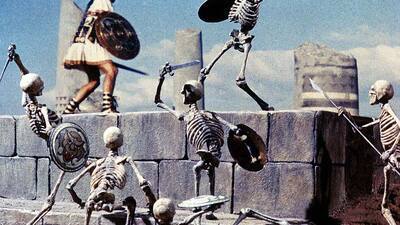
[ad_1]
(2) It establishes the relationship between gods and mortals in ancient mythology. which (to wildly oversimplify) goes something like: “These are super-beings, but they have the tangled psychology of the mortals that they toy with, and you can never fully understand why they obsess over certain things; it’s just how they are, and they don’t quite understand themselves, either, even if they believe that they do.” Hera’s relationship with Jason is something other than romantic, platonic, parental, or any of the other descriptors that tend to get applied to relationships in these kinds of films. It’s something else. And how wonderful it is that the film never explains it. It just lets it be. (Hera’s statue, which has eyes that open and close, and which is placed on the stern facing inward to watch over the crew, is as mesmerizing as any of the stop-motion creatures in the movie.)
Jason is pure of heart, sometimes to a fault, and always does the smart and honorable thing where his crew and loved ones are concerned (though he’s not above tricking an enemy, and there’s nothing wrong with that). But he’s more talented than wise when he starts his journey. It’s fun to see Jason being tested and growing into a formidable leader. He started out by convincing a crew to set sail across the ocean for no pay (what a movie producer he would have made!) but failed to bring enough water to keep them from dying of thirst. (Hera to the rescue.) By the end, you believe him as a leader of men who deserves his station in life.
And that’s where the movie ends, because it’s an old movie, and old movies knew where to end. They don’t give you seven more scenes of Argonauts traveling home and having a banquet and getting medals, and becoming dads, etc. It’s over when Jason has achieved peak Jason-ness, and he’s all out of help requests.
The effects by Ray Harryhausen don’t need to be sold by me here, perhaps except to say that he has never been properly appreciated as (for lack of a better word) a performer, an idea that was first suggested to me by my friend and RogerEbert.com colleague David Moses. The hydra, the harpies, the bronze giant and the skeleton warriors all pop because they seem to have actual personalities and are imagined with an actor-showman’s instincts: think of how a “big” actor from earlier times like Bette Davis or Boris Karloff would’ve played these creatures if motion capture had existed. Talos the bronze guardian seems creaky not just because he’s made of metal but because (like the Tin Man in “The Wizard of Oz”) he’s been up on that pedestal for so long that when he finally gets a reason to climb down and mess with some humans, he’s rusty in every since. (When I stand up after a three hour flight, I walk like Talos.) The skeleton warriors aren’t just grinning because skulls naturally have that rictus smile: they seem happy to be released to do what they did when they were alive, which is fight. When they go after Jason and his men, there’s a bounce in their step.
[ad_2]